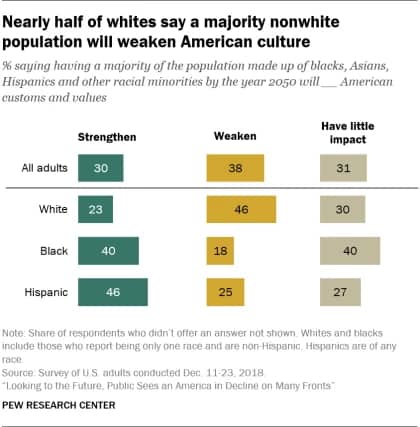Looking to the Future, Public Sees an America in Decline on Many Fronts
Kim Parker, Rich Morin and Juliana Menasce Horowitz, Pew Research Center, March 21, 2019
Americans peer 30 years into the future, they see a country in decline economically, politically and on the world stage. While a narrow majority of the public (56%) say they are at least somewhat optimistic about America’s future, hope gives way to doubt when the focus turns to specific issues.
A new Pew Research Center survey focused on what Americans think the United States will be like in 2050 finds that majorities of Americans foresee a country with a burgeoning national debt, a wider gap between the rich and the poor and a workforce threatened by automation.
Majorities predict that the economy will be weaker, health care will be less affordable, the condition of the environment will be worse and older Americans will have a harder time making ends meet than they do now. Also predicted: a terrorist attack as bad as or worse than 9/11 sometime over the next 30 years.
{snip}
The view of the U.S. in 2050 that the public sees in its crystal ball includes major changes in the country’s political leadership. Nearly nine-in-ten predict that a woman will be elected president, and roughly two-thirds (65%) say the same about a Hispanic person. And, on a decidedly optimistic note, more than half expect a cure for Alzheimer’s disease by 2050.
The public also has a somewhat more positive view – or at least a more benign one – of some current demographic trends that will shape the country’s future. The U.S. Census Bureau predicts that, by 2050, blacks, Hispanics, Asians and other minorities will constitute a majority of the population. About four-in-ten Americans (42%) say this shift will be neither good nor bad for the country while 35% believe a majority-minority population will be a good thing, and 23% say it will be bad.
These views differ significantly by race and ethnicity. Whites are about twice as likely as blacks or Hispanics to view this change negatively (28% of whites vs. 13% of blacks and 12% of Hispanics). And, when asked about the consequences of an increasingly diverse America, nearly half of whites (46%) but only a quarter of Hispanics and 18% of blacks say a majority-minority country would weaken American customs and values.

{snip}
Minorities are more optimistic than whites about the country’s future
{snip}
Black and Hispanic adults are among the most optimistic about the country’s future. Seven-in-ten blacks and two-thirds of Hispanics feel hopeful about America’s future. In contrast, about half of all whites (51%) are as confident. High school graduates and those with less education also are somewhat more positive about the country’s prospects than are college graduates (60% vs. 53%).
{snip}
The racial pattern switches when Americans are asked about the future of race relations over the next 30 years. Slightly more than half of all whites (54%) but 43% of blacks and 45% of Hispanics say relations will get better. Overall, the country is divided on the future of race relations: About half (51%) say they will improve, while 40% predict they will get worse.
{snip}
A majority of whites (56%) but only a third of blacks and four-in-ten Hispanics say the importance of religion will decline over the next 30 years. Adults with more formal education are more likely to see religion in eclipse than those with less: 54% of all college graduates but 43% of those with a high school degree or less education predict the declining importance of religion.
{snip}
Similar shares of most key demographic groups agree about who will pay the bills for long-term care in the future. But these groups often differ about who should be primarily responsible for the costs of this care. Two-thirds of blacks and Hispanics (67%) say government should be mostly responsible for paying for long-term care for older adults, while about half of whites (51%) agree. Similarly, two-thirds of adults ages 50 to 64 say government should be mostly responsible for this care compared with about half of all other age groups, including those 65 and older. In addition, two-thirds of Americans with family incomes under $30,000 look to government to cover the cost, compared with about half of those with higher incomes.
{snip}
Predictions about the future of marriage, divorce and childbearing differ by race
Overall, about half of adults (53%) say that, by 2050, people will be less likely to get married than they are today. Very few (7%) predict that people will be more likely to marry in the future, and 39% say things will stay about the same. Whites and Hispanics are much more likely than blacks to predict lower marriage rates in the future – 56% of whites and 53% of Hispanics say people will be less likely to marry compared with 34% of blacks. Blacks are the only group in which a majority say marriage rates will stay the same or increase. According to the U.S. Census Bureau, blacks are significantly less likely than whites or Hispanics to be married. Among those ages 18 and older, 31% of blacks were married in 2017 compared with 46% of Hispanics and 54% of whites.2
Predictions about the future of divorce reveal a somewhat different pattern. More than six-in-ten whites (64%) but half of blacks and 42% of Hispanics expect people will be about as likely to get divorced in 2050 as they are today. In this regard, Hispanics are more pessimistic than whites about the future state of marriage: 37% predict that people will be more likely to divorce in the future, compared with 27% of whites and 30% of blacks.
{snip}















